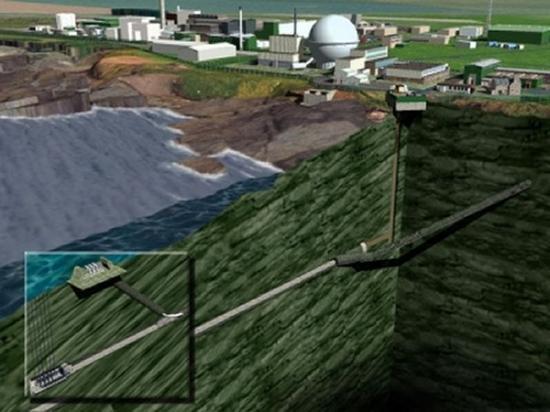
This site uses cookies, by continuing to use this site you accept the terms of our privacy policy
Feed 2.0 Loading...
Hi-tech "Worm" Probes Subterranean Pipeline
19th February 2009

A hi-tech "worm" is probing a subterranean pipeline used to discharge radioactive effluent from Dounreay between 1957 and 1992.
The �100,000 pipe crawler has sent back video and radiation readings during its five-day journey some 45 metres underground.
The data will be analysed by a project team investigating how to leave the disused system in a safe condition as part of the site clean-up.
A bundle of four cast iron pipes, each 23cm in diameter, was laid in the 1950s to discharge effluent from the fast reactor experiment.
It was connected on the surface at one end to two disused tanks where effluent drained from the reactors, chemical plants and waste facilities.
The pipeline bundle descends towards the sea along a sloping adit to a tunnel excavated 25 metres beneath the seabed.
At the end of the tunnel, some 600 metres offshore, the pipeline terminated in a diffuser attached to vertical risers that exited on the seabed 20 metres beneath the waves.
The pipes were encased in a thick concrete sleeve that runs along one side of the tunnel. When construction finished in 1957, the tunnel was abandoned and allowed to flood.
"The tunnel system has been flooded for more than half a century and the pipeline itself was taken out of routine use in 1992, so we don't know what condition the pipeline is in or if it safe to leave in place," explained Martin Howse, project manager with Dounreay Site Restoration Ltd.
"The remotely-operated vehicle will allow us to inspect the inside of the pipes. We are looking for signs of structural degradation, trapped debris and radioactive contamination.
"The findings will allow us to reach some judgements about the best course of action. It is our intention to present a proposal to the Scottish Environment Protection Agency by December."
The performance of the subsea discharge system started to deteriorate in the late 1970s. It was taken out of routine use in 1992 after a new plastic pipeline was installed in the tunnel and connected to a modern diffuser on the seabed.
Two companies with specialist remote inspection skills honed in the North Sea are carrying out the survey - MSIS and Hydropulsion.
The head of the "worm" is 2.5 metres long and 15cm in diameter. Its flexible tracked chassis can turn through bends in the pipes. An umbilical "tail" allows the pipeline crawler to be controlled remotely from the surface, where the project team can view "live" video and radiation readings.
Related Businesses
Related Articles
7/4/2025
Crane back in business - with a little help from Spot the robot dog at Dounreay
Spot, the robot "dog," recently assisted colleagues in Dounreay's Fuel Cycle Area by reactivating a crucial building crane in a reprocessing plant. The crane had been deactivated at the switchboard in 2023 due to concerns about the ageing asset.
15/2/2025
Dounreay to take on 23 new apprentices
One of Britain's most complex environmental restoration projects is taking on 23 new apprentices. The decommissioning of the former centre of fast reactor research and development at Dounreay is continuing to create long-term opportunities for young people.
18/11/2024
Nuclear Restoration Services Has Appointed Dave Wilson As Managing Director Of Its Dounreay Division
He joins from AtkinsRealis, where he was market director and delivery lead for its nuclear decommissioning and waste services business, and officially takes up the post today (18 November 2024), He succeeds John Grierson who has served as interim MD since May. NRS CEO Rob Fletcher said, "I am very pleased that Dave Wilson has agreed to join the team at Dounreay.
5/11/2024
NDA Supply Chain Award Winners 2024 Revealed
The Nuclear Decommissioning Authority group have announced five organisations as winners of this year's supply chain awards. Morgan Sindall Infrastructure, The Decommissioning Delivery Partnership, PA Consulting, Antech and The Higher Activity Waste Thermal Treatment Tranche 1 Team are the big winners in this year's supply chain awards.4/11/2024
UKAEA Monthly Newsletter Latest Edition
Find out what has been happening at UKAEA in our monthly newsletter. Read about our recent activities and upcoming events.
23/10/2024
My Experience On The Commissioning Graduate Programme At Sellafield Ltd
With a degree in electrical and electronic engineering and a keen interest in the nuclear sector, Anouschka knew Sellafield would be the best place for her to begin her career in the industry. That career has already seen her relocate from Sheffield to Cumbria and scooping the title of Sellafield Ltd Graduate of the Year.9/10/2024
Sellafield Ltd Welcomes Its Largest Ever Graduate Cohort
More than 140 graduates have started at Sellafield Ltd. Over 140 graduates have just started their exciting careers with the company in a range of business and technical disciplines, supporting Sellafield Ltd in its mission to create a clean and safe environment for future generations.
1/10/2024
UKAEA Newsletter - Edition 11 Published Today
Find out what has been happening at UKAEA in our monthly newsletter. Read about our recent activities and upcoming events.
27/9/2024
NDA Group Investing In Our Communities
The Nuclear Decommissioning Authority (NDA) group has on 26 September 2024 published its 2023 to 2024 socio-economic report detailing a record investment in projects across the UK. Over the last five years, the NDA group has invested £60 million in projects that enable permanent and sustainable change in its site communities, leveraging many millions more from partners.
26/9/2024



